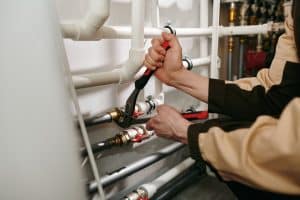Lead and copper rule Improvements: How They Impact Homeowners

Advertisement
Lead and copper rule improvements are reshaping how drinking water is safeguarded in communities across the country. For homeowners, these updates go beyond technical regulations, they directly affect the water flowing into your kitchen and bathroom every day.
If you’ve ever wondered about the hidden risks of old service lines or outdated plumbing, these new standards bring both reassurance and responsibility. They aim to lower exposure to harmful metals while pushing for greater transparency in water systems.
For families, the impact is personal: cleaner water, stronger public health protections, and clearer information about what’s in your pipes. Understanding these changes helps you stay ahead and make informed decisions for your home.
Understanding the lead and copper rule
For homeowners, understanding the Lead and copper rule improvements is the first step toward ensuring safe water at home. This federal regulation was designed to limit exposure to harmful metals by setting clear standards for water systems across the country.
Lead and copper can seep into drinking water through aging pipes and plumbing fixtures, and long-term exposure can cause serious health problems, particularly in children and pregnant women. By grasping how this rule works, you gain the tools to make smarter choices about your home’s water quality.
Advertisement
The improvements strengthen previous standards by tightening limits and demanding greater transparency from utilities. They not only require stricter monitoring but also focus on replacing old service lines that are most likely to leach metals.
This means the rule directly connects to the safety of water in your kitchen, bathroom, and every tap your family uses. Awareness of these updates helps homeowners understand where risks may exist and how they are being addressed.
Key Aspects of the Lead and Copper Rule
The Lead and copper rule improvements introduced new requirements that water suppliers must follow to protect public health. Utilities are now required to conduct more reliable sampling that reflects the true condition of household plumbing.
Advertisement
This means testing water where exposure is most likely, rather than relying on limited or less representative sites. By tightening these procedures, the rule ensures that problems are identified before they harm families.
In addition to sampling, the rule demands stronger corrosion control methods to reduce the amount of lead and copper that dissolves into water from older pipes.
If contamination levels exceed the updated thresholds, utilities must act quickly to notify residents and implement corrective measures.
One of the most significant changes is the obligation to replace lead service lines entirely within a set timeframe, an effort that directly reduces risks for millions of households.
These actions specifically target areas where older infrastructure poses the greatest threat. Homes built before modern plumbing standards often contain lead pipes, solder, or fittings that make them more vulnerable.
The rule acknowledges this reality and provides a framework to protect those most at risk.
Why It Matters
The Lead and copper rule improvements matter because they directly impact the safety of families who depend on municipal water systems.
For homeowners, knowing about these protections means you can take proactive steps rather than waiting for problems to appear. Regular testing of your home’s water can confirm whether your property is affected, giving you peace of mind or guiding you toward necessary upgrades.
Properties built before the 1980s are especially important to examine closely, since their plumbing may still contain materials that leach lead or copper.
By learning the history of your home and understanding your utility’s responsibilities under the rule, you can make informed decisions about replacements, filters, or other protective measures. These steps can prevent hidden risks from becoming serious health issues.
Ultimately, the improvements to the lead and copper rule aim to safeguard entire communities. They reduce the dangers of toxic exposure, push utilities toward accountability, and ensure that homeowners are kept informed.
By staying aware of how the rule works and what it demands, you can take part in protecting your household’s health and contribute to a safer water system for everyone.
Key improvements to the regulations
The Lead and copper rule improvements introduced in 2024 represent one of the most significant shifts in U.S. drinking water policy in decades.
These changes go beyond technical updates and demonstrate a national commitment to eliminating exposure to harmful metals in everyday water use.
By lowering the action level for lead from 15 parts per billion to 10, and requiring the full replacement of lead service lines within a 10-year period, the regulations set higher standards that utilities must follow.
For homeowners, this means stronger protections and more accountability from the water systems that serve their communities.
These improvements are designed not only to safeguard health but also to bring greater transparency. Residents now have the right to know if their homes are connected to lead service lines and when those pipes will be replaced.
This ensures that families are no longer left in the dark about risks hidden underground and can plan more confidently for the safety of their households.
Increased Sampling Requirements
One of the cornerstones of the Lead and copper rule improvements is the requirement for more comprehensive and representative water testing.
Utilities must now collect samples from locations that are most at risk, including older homes with known lead pipes, schools, and childcare centers where children are especially vulnerable to the effects of lead exposure.
This change ensures that data reflects real household conditions rather than limited or less accurate testing practices.
The rule also obliges utilities to expand the number of sites tested, increasing the chances of detecting contamination before it affects an entire neighborhood.
In addition, water systems must act quickly when results exceed safe limits, notifying affected residents within 24 hours instead of waiting weeks or months.
For homeowners, this rapid notification provides a vital early warning, allowing them to take immediate steps such as using filters, flushing taps, or seeking temporary alternatives until long-term solutions are in place.
By making sampling more rigorous and timely, these updates close a dangerous gap that previously allowed problems to persist unnoticed.
Families can now have greater confidence that their water is being closely monitored and that action will be taken without delay if contamination is found.
Enhanced Public Education
Another critical element of the Lead and copper rule improvements is the emphasis on public education and transparency.
Utilities are now required to provide clear, accessible information about water quality, testing schedules, and the status of lead service line replacements.
This communication must be designed to reach all residents, including those with limited English proficiency, ensuring that no household is left uninformed.
For homeowners, this means more than just receiving technical reports, it means practical advice on how to reduce risks inside the home.
Guidance may include steps such as flushing taps to minimize lead after water has been sitting overnight, identifying plumbing materials that could contribute to contamination, or choosing filters certified to remove lead effectively.
These educational measures empower residents to take active roles in protecting their families while long-term infrastructure improvements are underway.
The focus on transparency also helps build trust between communities and utilities, turning residents into informed partners rather than passive recipients of information.
By strengthening this relationship, the rule ensures that awareness leads to action, and action leads to healthier households.
Impact on home plumbing systems

The impact on home plumbing systems due to updates in the lead and copper rule is significant for homeowners. These changes can both improve household water quality and present challenges for older plumbing systems.
Understanding this impact is crucial for making informed decisions.
Homes built before the 1980s often have plumbing systems that include lead pipes, which can leach harmful metals into the drinking water. The new regulations mean that these homeowners need to be more vigilant about their water quality.
Older plumbing may require upgrades to comply with updated safety standards.
- Evaluating existing pipe materials for lead content;
- Scheduling regular water testing for lead and copper levels;
- Considering replacement options for outdated plumbing.
By taking these steps, you can mitigate the risks associated with lead exposure.
As more homeowners become aware of the lead and copper rule, many are also motivated to make necessary upgrades. For instance, switching to copper or PVC pipes can help eliminate the risk posed by lead.
Additionally, installing water filters certified to remove lead can provide extra protection.
Awareness of these changes encourages homeowners to take action. When you know the risks, it’s easier to find solutions, such as:
- Choosing certified filters for drinking water;
- Requesting assistance from local water authorities;
- Educating family members about safe water practices.
By addressing plumbing system issues, families can enjoy cleaner and safer drinking water. Homeowners should stay informed about their local regulations and options available for upgrading plumbing systems.
Benefits for homeowners and communities
The Lead and copper rule improvements bring significant advantages that extend far beyond compliance with federal standards. For homeowners, these changes mean safer tap water and greater transparency about what is flowing into their homes.
For communities, they establish stronger safeguards that promote collective well-being, reduce inequalities in water quality, and ensure that even vulnerable populations are protected.
Understanding these benefits helps both individuals and neighborhoods see how regulations translate into meaningful improvements in daily life.
By focusing on stricter monitoring and mandatory lead service line replacement, the improvements guarantee that entire communities move toward healthier living environments.
They also reinforce trust in public utilities, which are now required to communicate more clearly and act more quickly when contamination is detected. This creates a safer, more informed, and more resilient society where water safety is no longer a privilege but a shared right.
Improved Health Outcomes
Perhaps the most important benefit of the Lead and copper rule improvements is the potential for long-term health gains. Lead exposure has long been linked to serious developmental delays in children, ranging from learning difficulties to behavioral challenges.
For adults, chronic exposure increases the risk of cardiovascular disease, kidney problems, and other serious health conditions. By lowering the lead action level from 15 parts per billion to 10 and demanding full replacement of lead service lines within a decade, the rule directly addresses these threats at their source.
Healthier children growing up with reduced risks of cognitive impairment represent one of the most powerful outcomes of this regulation. Adults, too, benefit from lower rates of chronic illnesses tied to heavy metal exposure.
On a broader scale, communities experience reduced strain on healthcare systems and fewer long-term medical costs. This health-focused approach not only safeguards families but also builds stronger, more vibrant communities where everyone has a better chance of thriving.
These outcomes are especially meaningful in neighborhoods historically affected by aging infrastructure, where families have carried a disproportionate burden of contamination. By prioritizing equity, the rule ensures that health benefits reach those who need them most.
Financial Advantages
The Lead and copper rule improvements also deliver important financial benefits to both households and communities. For homeowners, cleaner water reduces the need for costly filtration systems or frequent maintenance of household plumbing.
Families can save money on medical expenses related to lead exposure, which can otherwise accumulate over years of unnoticed contamination. These savings, though indirect, are significant and contribute to greater financial stability over time.
For communities, early detection and prevention of contamination help utilities avoid expensive emergency interventions. By proactively replacing lead service lines and improving corrosion control, municipalities can prevent crises that would demand large-scale, costly remediation.
The federal government is also supporting these efforts with billions in funding through initiatives such as the Drinking Water State Revolving Fund, easing the financial burden on local systems and ensuring that upgrades remain affordable.
Beyond direct savings, these improvements strengthen community confidence and support for local water initiatives.
When residents see that investments in safer infrastructure translate into tangible benefits, they are more likely to participate in advocacy efforts, creating a cycle of accountability and progress.
Financially and socially, this creates a win-win situation that strengthens the link between individual households and the communities they are part of.
What homeowners should know about compliance
What homeowners should know about compliance with the lead and copper rule is essential for ensuring safe drinking water. Understanding these regulations helps you make informed decisions about your water supply and can prevent health issues.
Homeowners must be aware of their responsibilities under the new regulations. It’s important to know if your home is affected by these rules, especially if you live in an area with older plumbing.
Compliance means ensuring that your water does not exceed the allowable levels of lead and copper.
- Regularly test your drinking water for lead and copper;
- Consider replacing lead plumbing if necessary;
- Stay informed about local water quality reports.
By being proactive, you can help safeguard your family’s health and meet compliance requirements.
Homeowners should also work closely with their local water authorities. These agencies can provide essential resources and guidance regarding compliance. They may offer testing services or information on plumbing upgrades to ensure safety.
Key points for homeowners include:
Staying engaged with your local water authority helps ensure that you are not only compliant but also informed about the ongoing efforts to improve water quality in your area.
Finally, homeowners should educate themselves about the potential impacts of the lead and copper rule on their property values. Investing in plumbing upgrades can enhance home safety and market value.
Understanding compliance can lead to peace of mind and contribute positively to the community.
FAQ – Frequently Asked Questions about Lead and Copper Rule Improvements
What is the lead and copper rule?
The lead and copper rule is a regulation designed to limit lead and copper levels in drinking water to protect public health.
How do the improvements affect homeowners?
The improvements help ensure safer drinking water, reduce health risks, and encourage homeowners to upgrade their plumbing systems.
What should I do if my home has lead pipes?
If your home has lead pipes, you should consider replacing them and testing your water regularly to ensure safety.
How can I stay informed about local water quality?
You can stay informed by checking local water authority reports, participating in community meetings, and following updates about compliance measures.





